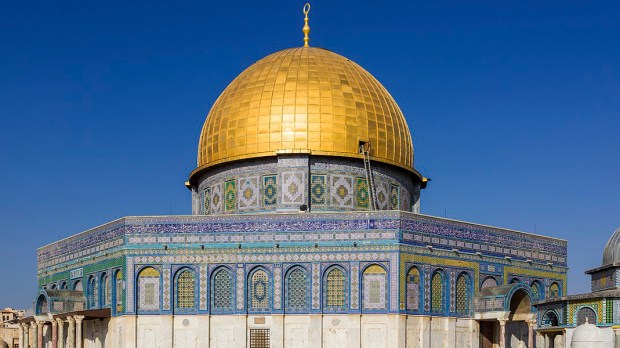For nearly two centuries of the Middle Ages, European countries mustered armies and sent them on Christian Crusades into the Middle East in order to wrest control of the region from the Seljuk Turks. The series of invasions, which ushered a nearly constant stream of Westerners from all walks of life to the Holy Land, led to the conquering of the Palestine region.
The West only ruled the land from Jerusalem for 90 years, and in that time they persecuted Jews and “heretical” Christians, campaigned to push the Muslims off the Iberian Peninsula and out of North Africa, and claimed Jerusalem for their own. Today, we are so far removed from the Crusades that there is very little evidence of them in the Holy City, but in that short, busy time the Crusaders built a number of churches and city infrastructure.
To better understand the Crusades we turn to Jack Meinhardt, whose essay “When Crusader Kings Ruled Jerusalem” was reproduced by Bible History Daily. Meinhardt explains that the catalyst that began the Crusades was the 8th-century invasion of the Near East by the Seljuk Turks. The Turks converted to Islam after arriving and proceeded to subdue the reigning Arab power, the Abbasid caliphate in Baghdad, before spreading out to take control of the entire region.
Before the rise of the Turks, the Byzantines and the caliphate had been open to all and were very accepting of the Christians, but the Seljuk advance significantly diminished the Christian influence of the Near East. The most notable change, as far as the Westerners were concerned, was that European pilgrims could no longer walk the ancient roads in the footsteps of Christ.
Meinhardt writes:
The Byzantine emperor Alexius I appealed to the West for help. In 1095 Pope Urban II responded; in a speech delivered at Clermont, in central France, he called for a crusade to save the Christian East from Islam. Seljuk Turks, Urban reportedly said, were disemboweling Christians and dumping the bloody viscera on church altars and baptismal fonts. Those who joined this crusade, or “took the cross,” the pope announced, would have their sins absolved, for God himself desired that Christianity recover Jerusalem.
The grim reports of the killing of Christians spurred European noble and royal families to raise armies from their own estates. One in particular was led by three brothers, Eustace, Baldwin and Godfrey; Godfrey and Baldwin would become the first rulers of the Latin Kingdom of Jerusalem. Other Crusaders included various members of French, Norman, German, and Italian nobility and even princes.
The First Crusade commenced in 1095 and saw European forces march over Anatolia and lay siege to Antioch. By 1098, the city fell to the Crusaders and became their first colony in the Near East. From their new stronghold, they marched south, where Jerusalem fell after a two-week siege. Meinhardt writes that the Muslim rulers surrendered without a fight:
The next morning, however, Jerusalem became a killing field as the conquerors slaughtered nearly every Muslim in the city and burned down a synagogue in which Jews had sought refuge. “With drawn swords our men ran through the city not sparing anyone, even those begging for mercy,” wrote Fulcher of Chartres, who served as Baldwin’s chaplain. “They desired that this place, so long contaminated by the superstition of the pagan inhabitants, should be cleansed from their contagion.”
During the following decades, the Crusaders secured all of the major coastal cities and strengthened their position by building forts in strategic locations. By the mid-12th century, the entire region of Levant had become a colony of what was called the Latin Kingdom of Jerusalem.
On the Holy City, the Crusaders left only a few traces of their time in command. One of the biggest changes they made was to the Dome of the Rock, which they took particular interest in after they learned of its association with such biblical events as the presentation of Christ in the Temple (Luke 2:22–38) and Jacob’s dream of a ladder to heaven (Genesis 28:11–17). They set to converting the Muslim Dome of the Rock into a Christian church and renamed it “Templum Domini.”
The kings who led the Crusades commandeered the Al-Aqsa Mosque, in the Old City, as their residence, but later moved to the newly constructed Tower of David. The Mosque was then converted to housing for Templar Knights, an order that began as pilgrim guards and became an elite fighting force. The Crusaders also constructed a city gate, a covered market, a hospital, and various other buildings of infrastructure.
The most prevalent form of Crusader construction, however, was the church. Meinhard lists some of the churches they built, which are still standing and in use today:
East of the city, on the Mount of Olives, they built the Church of the Tomb of the Virgin … Just north of the northeast corner of the Temple Mount, they erected the splendid Romanesque Church of St. Anne. The Crusaders’ most enduring architectural legacy, however, is their rebuilding of the Church of the Holy Sepulchre.
The Crusaders’ rule of Jerusalem was relatively short-lived by historical standards. In 1187 the sultan Saladin, who had unified the Egyptian and Syrian regions, defeated the forces of the Latin Kingdom of Jerusalem and retook the Holy City.
This was the end of the First Crusade, but six more major Crusades and countless minor ones would continue for another century. The Crusaders maintained a presence in the coastal cities of Tyre and Acre, keeping a thin strip of territory that would expand and contract with each new Crusade. The Crusader presence in the Middle East was finally quashed when their last city, Acre, fell in 1291.

